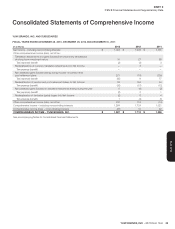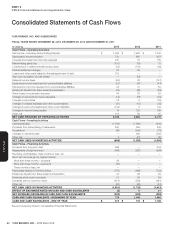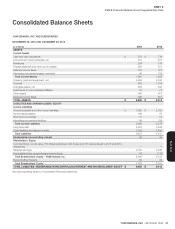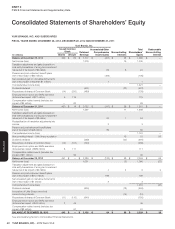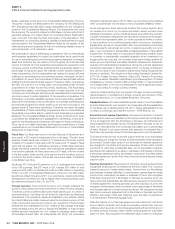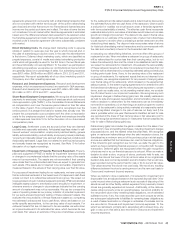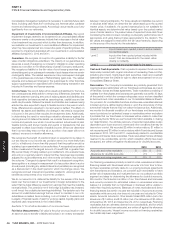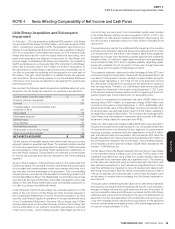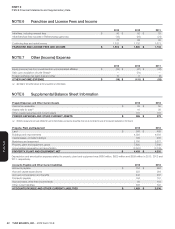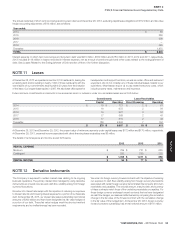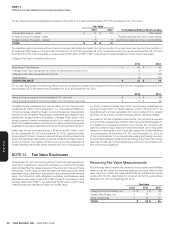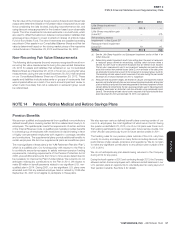Pizza Hut 2013 Annual Report Download - page 144
Download and view the complete annual report
Please find page 144 of the 2013 Pizza Hut annual report below. You can navigate through the pages in the report by either clicking on the pages listed below, or by using the keyword search tool below to find specific information within the annual report.
YUM! BRANDS, INC.-2013 Form10-K48
Form 10-K
PART II
ITEM 8Financial Statements andSupplementaryData
our impairment analysis, we update the cash flows that were initially used
to value the definite-lived intangible asset to reflect our current estimates
and assumptions over the asset’s future remaining life�
Derivative Financial Instruments. We use derivative instruments primarily
to hedge interest rate and foreign currency risks� These derivative contracts
are entered into with financial institutions. We do not use derivative
instruments for trading purposes and we have procedures in place to
monitor and control their use.
We record all derivative instruments on our Consolidated Balance Sheet
at fair value. For derivative instruments that are designated and qualify as
a fair value hedge, the gain or loss on the derivative instrument as well as
the offsetting gain or loss on the hedged item attributable to the hedged
risk are recognized in the results of operations. For derivative instruments
that are designated and qualify as a cash flow hedge, the effective portion
of the gain or loss on the derivative instrument is reported as a component
of other comprehensive income (loss) and reclassified into earnings in
the same period or periods during which the hedged transaction affects
earnings. For derivative instruments that are designated and qualify as a net
investment hedge, the effective portion of the gain or loss on the derivative
instrument is reported in the foreign currency translation component of
other comprehensive income (loss). Any ineffective portion of the gain or
loss on the derivative instrument for a cash flow hedge or net investment
hedge is recorded in the results of operations immediately� For derivative
instruments not designated as hedging instruments, the gain or loss is
recognized in the results of operations immediately� See Note 12 for a
discussion of our use of derivative instruments, management of credit risk
inherent in derivative instruments and fair value information�
Common Stock Share Repurchases. From time to time, we repurchase
shares of our Common Stock under share repurchase programs authorized
by our Board of Directors� Shares repurchased constitute authorized,
but unissued shares under the North Carolina laws under which we are
incorporated� Additionally, our Common Stock has no par or stated value�
Accordingly, we record the full value of share repurchases, upon the trade
date, against Common Stock on our Consolidated Balance Sheet except
when to do so would result in a negative balance in such Common Stock
account� In such instances, on a period basis, we record the cost of any
further share repurchases as a reduction in retained earnings� Due to the
large number of share repurchases and the increase in the market value
of our stock over the past several years, our Common Stock balance
is frequently zero at the end of any period� Accordingly, $640 million,
$794million and $483 million in share repurchases were recorded as a
reduction in Retained Earnings in 2013, 2012 and 2011, respectively. See
Note 16 for additional information.
Pension and Post-retirement Medical Benefits. We measure and recognize
the overfunded or underfunded status of our pension and post-retirement
plans as an asset or liability in our Consolidated Balance Sheet as of our
fiscal year end. The funded status represents the difference between the
projected benefit obligations and the fair value of plan assets, which is
calculated on a plan-by-plan basis. The projected benefit obligation and
related funded status are determined using assumptions as of the end of
each year. The projected benefit obligation is the present value of benefits
earned to date by plan participants, including the effect of future salary
increases, as applicable. The difference between the projected benefit
obligations and the fair value of plan assets that has not previously been
recognized in our Consolidated Statement of Income is recorded as a
component of Accumulated other comprehensive income (loss).
The net periodic benefit costs associated with the Company’s defined
benefit pension and post-retirement medical plans are determined using
assumptions regarding the projected benefit obligation and, for funded
plans, the market-related value of plan assets as of the beginning of each
year. We have elected to use a market-related value of plan assets to
calculate the expected return on assets in net periodic benefit costs. We
recognize differences in the fair value versus the market-related value of
plan assets evenly over five years. For each individual plan we amortize into
pension expense the net amounts in Accumulated other comprehensive
income (loss), as adjusted for the difference between the fair value and
market-related value of plan assets, to the extent that such amounts
exceed 10% of the greater of a plan’s projected benefit obligation or
market-related value of assets, over the remaining service period of active
participants in the plan or, for plans with no active participants, over the
expected average life expectancy of the inactive participants in the plan.
We record a curtailment when an event occurs that significantly reduces
the expected years of future service or eliminates the accrual of defined
benefits for the future services of a significant number of employees. We
record a curtailment gain when the employees who are entitled to the
benefits terminate their employment; we record a curtailment loss when
it becomes probable a loss will occur.
We recognize settlement gains or losses only when we have determined
that the cost of all settlements in a year will exceed the sum of the service
and interest costs within an individual plan.
NOTE3 Earnings Per Common Share (“EPS”)
2013 2012 2011
NET INCOME – YUM! BRANDS, INC. $ 1,091 $ 1,597 $ 1,319
Weighted-average common shares outstanding (for basic calculation) 452 461 469
Effect of dilutive share-based employee compensation 9 12 12
WEIGHTED-AVERAGE COMMON AND DILUTIVE POTENTIAL COMMON SHARES
OUTSTANDING (FOR DILUTED CALCULATION) 461 473 481
BASIC EPS $ 2.41 $ 3.46 $ 2.81
DILUTED EPS $ 2.36 $ 3.38 $ 2.74
UNEXERCISED EMPLOYEE STOCK OPTIONS AND STOCK APPRECIATION
RIGHTS (IN MILLIONS) EXCLUDED FROM THE DILUTED EPS COMPUTATION(a) 4.9 3.1 4.2
(a) These unexercised employee stock options and stock appreciation rights were not included in the computation of diluted EPS because to do so would have been antidilutive for the periods
presented.



